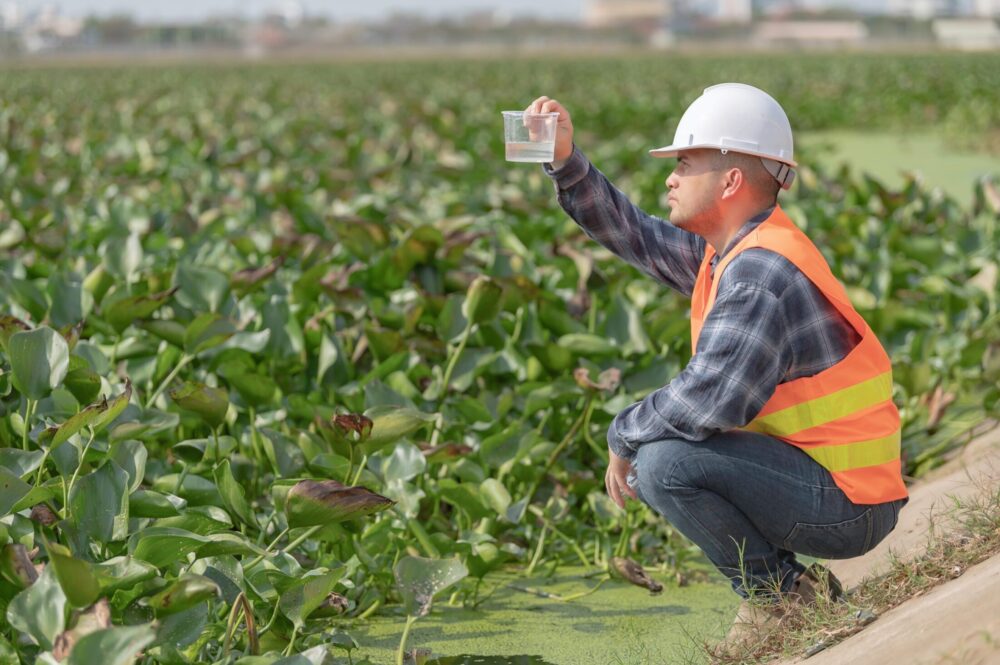The release of chemicals that have negative human or environmental health impacts has been rife around the world for a century. Approaches to contaminated site remediation have evolved over this time to address environmental contamination. Over the past 15 years there has been an increasing focus on sustainability in remediation. Bioremediation has emerged as a remediation technology of choice based on sustainability credentials. Research on pollutant biodegradation, including the discovery and characterisation of microbes responsible, underpins biological remediation applications.
Chemical contamination and contaminated site remediation
Research into the biotransformation of chemical compounds by microorganisms underpins environmental biotechnologies such as wastewater treatment, anaerobic digestion and bioremediation of contaminated sites. Such technologies are well established and arguably essential in our collective quest to minimise our impact on human and environmental health globally. Sustainable remediation technologies such as bioremediation have especial pertinence given the rate at which society has been polluting the environment over the past century.
International conventions on pollution compel nations and states to develop guidelines, legislation and regulations limiting production and use of harmful chemistry and stipulating trigger values for contaminated site clean-up action. The most common contamination events are the leakage of petroleum hydrocarbons from underground storage tanks, the release of chlorinated organics (organochlorines) from dry cleaning and mechanical facilities, the inappropriate disposal of asbestos and mishandling of heavy metals. The widespread use of fluorinated organics (e.g. perfluoroalkyl substances, PFAS, in fire-fighting foams) has also risen to prominence in recent years.
Less common but more serious in scale and impact are contamination events arising from chemical manufacturing facilities. Examples include the Botany Industrial Park in Sydney and the Altona Chemical Complex in Melbourne. Industrial-scale chemical production and handling has resulted in massive soil, groundwater and surface water contamination that can lead to human exposure through direct dermal contact, ingestion and inhalation.
Acute exposure to toxic chemicals can have dramatic impacts on human health leading to rapid cardiac or respiratory failure. Such incidences are rare, however. More common, and therefore concerning, is the long-term exposure of humans to low concentrations of environmental contaminants. This can lead to increased incidences of cancer, liver failure, reduced reproductive success and immune system malfunction. Beyond impacts on human and environmental health, contaminated sites can cause massive disruption in large public and private infrastructure development projects. Examples include the impact of PFAS on the West Gate Tunnel project in Melbourne and the impact of coal tar on the Barangaroo development in Sydney.
Australia has a strong international reputation in common-sense environmental consulting and contracting in the contaminated-site remediation industry. This is rooted in a risk-based approach to ensure potential harm to sensitive environmental or human receptors is minimised while encouraging sustainable efforts to clean up contaminated sites. Sustainability in this sense encompasses social, economic and environmental considerations.
When chemical contamination of the environment is discovered (e.g. chlorinated solvents from dry cleaning operations or petroleum hydrocarbons from petrol stations), iterative rounds of site characterisation are used to develop a conceptual site model enabling development of a risk-based remediation strategy as stipulated in the National Environment Protection (Assessment of Contaminated Sites) Measure (1999) for contaminated sites. Remediation technology options are then assessed through cost, benefit and sustainability analyses to ensure viable approaches to managing risk are economically feasible, supported by various stakeholders and have minimal negative environmental impacts. Finally, a remediation action plan is developed and executed.
The Australasian Land and Groundwater Association (ALGA) supports the Sustainable Remediation Forum (SuRF-ANZ), which is a member of the International Sustainable Remediation Alliance. The SuRF-ANZ envisions the principles of sustainable remediation to not only be applied but be recognised as a necessary part of developing a site remediation and management strategy. Additionally, they envision having the principles written into formal regulatory requirements to be a normal part of responding to site contamination.
Bioremediation as a sustainable remediation technology option
The National Environment Protection Council of Australia publishes National Environment Protection Measures that specify national standards for contaminated site remediation. The National Environment Protection (Assessment of Contaminated Sites) Measure (1999) provides remediation practitioners (environmental consultants and contractors) with a hierarchy of preferred remediation options. Ideally, contamination is treated in situ. If this is not possible, the preference is for contamination to be extracted and treated on site. The least preferred option is for contamination to be removed from the site and treated or disposed of elsewhere. It is up to state and territory governments to legislate requirements for site remediation.
First and foremost, a remediation technology for any given site must have the ability to contain, extract or transform the pollutant in question from the matrix it is contaminating. Containment of contaminant mass using physical barriers or restricting access to particular sites is often a cost-effective approach to mitigating immediate risk, but leaves contaminants in situ for future generations to manage.
Removal of contaminated materials from a site using heavyhanded engineering approaches such as ‘dig and dump’ and ‘pump and treat’ relieves the need for future management of a site, but risks the spread of contamination and often just moves the risk to another location. As sustainability has risen in importance as a selective criterion, these approaches have lost favour given that they are generally costly, energy intensive with associated greenhouse gas emissions, and disruptive to the environment in the case of large-scale excavation or groundwater extraction.
This century has seen the development and widespread application of more-nuanced remediation technologies that transform pollutants in situ to benign products with greatly reduced or unmeasurable impacts on human or environmental health. An example is in situ chemical oxidation using strong oxidising agents to mineralise contaminants. This can be cost effective but comes with risks in application and effectively sterilises the contaminated matrix. Another example is in situ chemical reduction using reducing agents such as zero-valent iron to chemically reduce contaminants to reduce toxicity. There are, however, extremely challenging sites for which it is not feasible to remediate with any of the aforementioned technologies based on sustainability.
The estuarine sediments of Homebush Bay, adjacent to the formerly heavily industrialised Rhodes Peninsula, is one such example. Chemical manufacturing during the 20th century resulted in heavy dioxin contamination of the harbour sediments, resulting in a commercial fishing ban west of the Sydney Harbour Bridge. Although the most heavily contaminated sediments were successfully excavated and treated using ex situ physical and chemical approaches by c. 2010, there is no viable remediation option for treating the remaining contamination, which continues to be a source of dioxin contamination throughout Port Jackson. This is glamorous Sydney Harbour’s dirty secret and bioremediation might just be the solution.
Anaerobic biodegradation research underpins subsurface bioremediation applications
Our approach to addressing organochlorine contamination in anaerobic environments is to discover and characterise novel bacteria that can transform these toxic compounds into harmless or less-harmful derivatives. For example, we have discovered two bacteria, Dehalobacter restrictus strain UNSWDHB and Formimonas warabiya strain DCMF, that can work together to transform chloroform (a common toxic groundwater pollutant) to dichloromethane (less harmful than chloroform) and then acetate (harmless). Another example is the discovery of a Dehalobium species that can seductively dechlorinate the most toxic dioxin found in Sydney harbour sediments (2,3,7,8-tetrachlorodibenzo-p-dioxin) to the much less toxic trichlorodibenzo-p-dioxin congener.
Discovery of novel organochlorine-degrading bacteria is achieved by using sediment or water from an organochlorinecontaminated environment as an inoculum in anaerobic microcosms. Typically, under this condition we expect to observe organochlorine respiration, where the organochlorine of interest is used as the respiratory terminal electron acceptor resulting in the removal of chloride from the organochlorine. Obligate organochlorine-respiring bacteria (ORB) are heterotrophs that use hydrogen as the electron donor and acetate and bicarbonate as organic and inorganic sources of carbon respectively. Therefore, these substrates are supplied in the anaerobic growth medium. After the initial organochlorine pulse has been depleted it is immediately resupplied. This cycle is repeated and at each iteration 16S rRNA gene amplicon sequencing is performed to follow the change in community profile, and to identify ORB involved in degrading the organochlorine. Several serial transfers with ~1% inoculation of the parent culture can result in enrichment of the desired ORB to ~90% of the microbial population.
For use at an organochlorine contaminated site, laboratoryscale microcosms in the order of 100 mL must be scaled up by ~1000-fold (i.e. 100 L). We have found that beer kegs are ideal for this purpose as they can maintain anaerobic conditions, are solvent resistant and are cost effective. ORB cultures that are grown in 20-L kegs can then be deployed at contaminated sites in existing groundwater monitoring wells. Once the cultures are in situ, tracking their activity in a dynamic system such as a subsurface aquifer can be challenging. This is because environmental factors can cause large fluctuations in contaminant concentrations. To overcome this challenge a number of steps are taken to functionally characterise ORB so that more than contaminant concentration can be used to confirm in situ degradation of the target organochlorine.
Firstly, the gene encoding the functional enzyme (i.e. the reductive dehalogenase; Rdase) is elucidated so that in situ functional cell numbers can be correlated with contaminant or degradation product concentrations. The Rdase is discovered using native polyacrylamide gel electrophoresis (PAGE)-coupled–liquid chromatography–mass spectroscopy (LCMS) and biochemical activity assays. Proteins expressed during cell growth by organohalide respiration are extracted under anaerobic conditions and separated by electrophoresis in their nondenatured and therefore functional form. Discrete protein bands are excised from the gels and tested for activity in anaerobic activity assays that contain a range of organohalides. When the active protein band is identified, the amino acid sequence of the reductive dehalogenase is determined by liquid chromatography– tandem mass spectroscopy (LC-MSMS). The amino acid sequence is then in silicon reverse translated to its corresponding nucleotide sequence, which can then be retrieved from the ORB genome. From here qPCR primers can be made for targeted in situ tracking of ORB alongside contaminant depletion.
The isotope enrichment factor is a unique signature associated with different chemical reaction mechanisms and can therefore be used for confirming or differentiating between different contaminant degradation pathways. The isotope enrichment factor for the ORB-facilitated attenuation of a specific organochlorine is determined by gas chromatography–combustion–isotope ratio mass spectroscopy (GC-C-IRMS). GC-C-IRMS ascertains the stable carbon or chlorine isotope ratios of individual organochlorines after GC separation. The mathematical relationship between the changes in isotope ratio v. change in organochlorine concentration provides the unique isotope enrichment factor for the in situ assessment of ORB activity.
Written by Matt Lee and Mike Manefield.
Matt Lee initially had a lengthy career as an analytical chemist working in the areas of environmental, agricultural and forensic chemistry. Matt obtained a PhD in plant biochemistry from the University of Western Australia (2007). Following the completion of his PhD, his research direction changed to anaerobic microbiology at UNSW. Here Matt has been studying anaerobes that use toxic organohalides as their respiratory electron acceptor thus making them less toxic. These microorganisms are crucial for the remediation of organohalide-contaminated environments.
Mike Manefield is an environmental microbiologist who teaches environmental science and engineering in the School of Civil and Environmental Engineering at UNSW. His primary research interest is in pollutant biodegradation. He has published over 130 articles and supervised over 45 PhD, Masters and Honours candidates to completion. He is founder of Novorem Pty Ltd (https://novorem.com.au) supporting Australian industry with environmental microbiology expertise.




